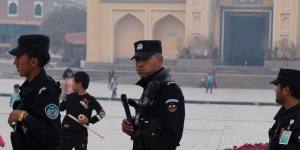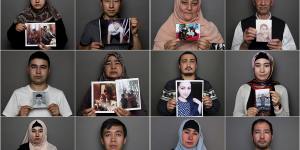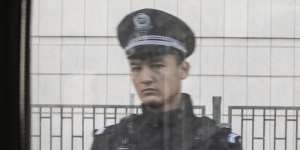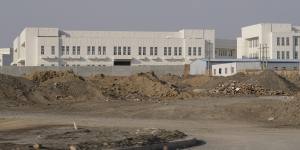
Security personnel on patrol outside a mosque attended by Uighurs in Xinjiang.Credit:AP
Security cameras,checkpoints and body scanners have become ubiquitous in public places across the province. Police routinely interrogate citizens,search their phones and collect biometric data and DNA. Analysis of satellite imagery indicates that many mosques,shrines and graves have been demolished. Authorities have targeted basic practices of Muslim faith,including fasting,beards and headscarves. Uighurs living abroad have spoken about losing contact with relatives in Xinjiang as authorities seek to cut of the flow of information.
“It’s really about transforming the population,” says Darren Byler,an anthropologist specialising in Uighur culture. “At the end of the day,they want to assimilate the Uighurs. They want to break them. They want to transform them and bring them into the mainstream Chinese economy.”

Uighurs in Australia with photos of relatives who are in internment camps,are missing or have died.Credit:Alex Ellinghausen
What is behind the crackdown?
The Uighurs have long had an uneasy relationship with Chinese rulers,right back to the days of the Qing dynasty. In the decades following the dynasty's collapse in 1912,there were short-lived efforts to establish an independent state. Communist revolutionary Mao Zedong then re-asserted control of Xinjiang in 1949.
Tensions have risen in recent decades,as the government escalated economic development and entrenched its political authority. Millions of members of the Han Chinese ethnic majority migrated to Xinjiang and now account for roughly the same proportion of the population as Uighurs,who once dominated.
Loading
James Leibold,an expert on Chinese ethnic policy at La Trobe University,calls it a “classic case of colonial domination” involving annexation,occupation,repression and expunging native culture. This has led to bouts of violent resistance and crackdowns by authorities in response.
Large anti-government riots rocked the regional capital,Urumqi,in 2009. Tensions peaked around 2014 with a series of violent attacks. In one high-profile incident,car bombs killed 31 and injured dozens in Urumqi. In another,a group of knife-wielding assailants killed 29 people at a railway station.
The spike in violence triggered a harsh crackdown by Chinese authorities,who declared they would stamp out separatism and terrorism. Documents leaked toThe New York Times showed that China's President Xi Jinping provided the impetus for the campaign,urging an all-out struggle using the “organs of dictatorship”,“a period of painful,interventionary treatment” and showing “absolutely no mercy”. In 2016,Chen Quanguo – a hardline Chinese Communist Party official who had overseen Beijing’s suppression of resistance in Tibet – was installed in Xinjiang to oversee the effort. He commanded a “smashing,obliterating offensive” and urged colleagues to “round up everyone who should be rounded up”.

A police officer seen through a train window in Turpan,Xinjiang,in 2018.Credit:Bloomberg
The Communist Party of China is highly sensitive to any perceived threats to its leadership and security,including resistance from independence movements in peripheral territories such as Xinjiang. They feared the chaos of rebellion seen with the Arab spring of the early 2010s.
“The fear of separatism or ‘splitism’,mapped onto fears of Islamic insurrection,provided ideological justification for a far more heavy-handed approach under Xi,” says Leibold.
Xinjiang is also rich in natural resources and forms part of Xi's signature Belt and Road Initiative,a massive infrastructure,investment and trade strategy spanning Europe and Asia.

A re-education camp,officially known as a vocational education and training centre,on the outskirts of Turpan City,Xinjiang.Credit:
How has China justified its actions?
China has long exercised tight control over information coming out of Xinjiang. As reports emerged of the escalating crackdown,the government initially denied the existence of the indoctrination camps. More recently,amid rising international pressure,they have acknowledged the centres and defended them as facilities for vocational education and training and “transformation through education”.
The party says its efforts in Xinjiang are needed to curb terrorism. Since the United States-led “war on terror” began following the September 11 attacks,Chinese rhetoric around Islamist terrorism has become intertwined with the issue of separatism in Xinjiang. Authorities have rejected criticism of the camps,saying they have been effective in ending violence and China has been contributing to global efforts to combat terrorism.
Following theTimes publication of the leaked documents,an opinion piece in the nationalist state-owned Chinese newspaper theGlobal Times,said"Western public opinion used their value system to criticise"the Xinjiang crackdown."Terrorism in Xinjiang has gradually been eliminated since these centers were set up. No more ordinary people are killed by rioters,"the piece argued.
Loading
Leibold says the government’s response goes way beyond the terrorism policies of Western countries,where governments have sought to counter violent extremism with targeted efforts to address radicalisation in communities.
“Instead,China has indiscriminately rounded up anyone who is Uighur or another Muslim minority and subjected them to this extradjudicial,coercive indoctrination,” he says. Chinese authorities have depicted Islam as a “virus” that has infected the population and must be purged.
“The threat is not at the same level as threats in other nations,” says Byler. He says the Chinese government’s “organised cruelty” is not justified and captures the entirety of the Muslim population,not discriminating between the innocent and violent. The efforts have gone beyond the population centres close to Pakistan and Afghanistan,considered hotspots for resistance,to encompass the entire province.